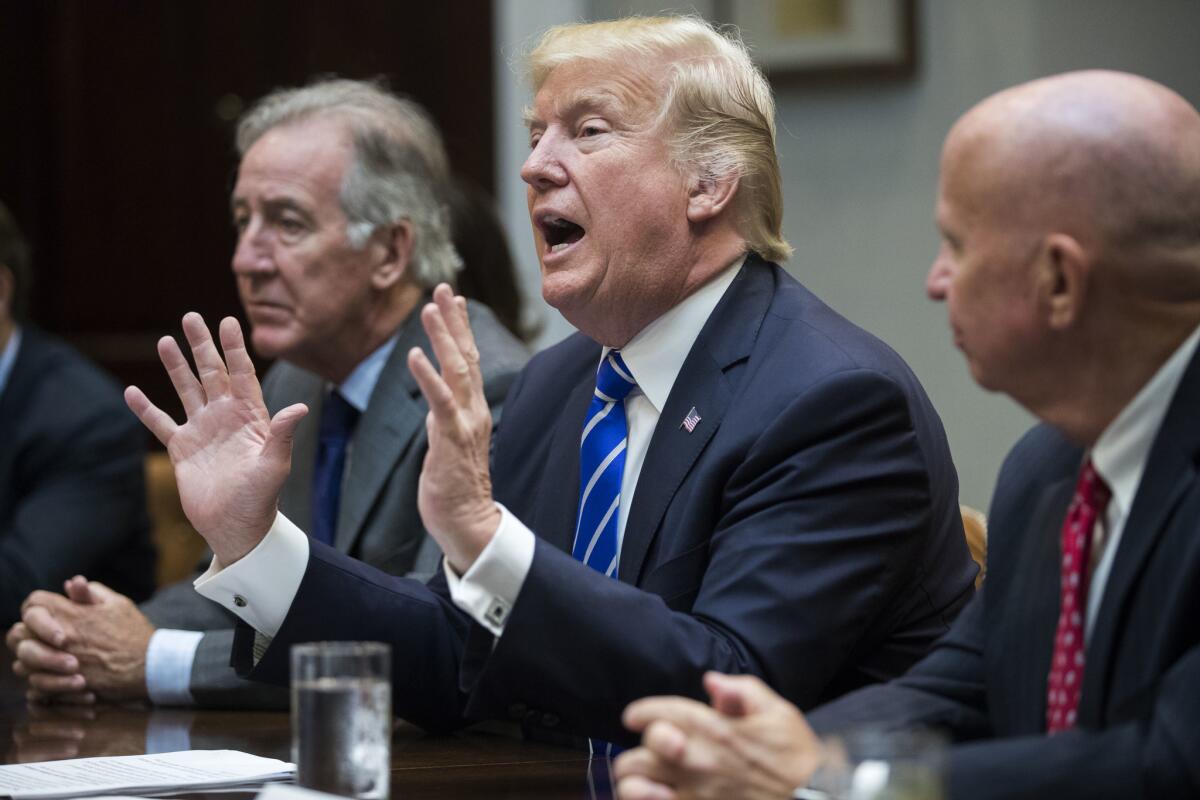Capitol Journal: Why Trumpâs tax plan may be the best thing for Californiaâs rickety tax system

Reporting from In Sacramento â President Trump believes people no longer should be allowed to deduct state and local taxes when calculating their federal income taxes. And they shouldnât. Heâs right.
That may sound nutty and even disloyal coming from a Californian. Millions of state residents, after all, would be hammered by elimination of the state and local tax deductions.
But letâs be intellectually honest. Thereâs no credible justification for the federal government subsidizing Californiaâs highest-in-the-nation state income tax â or, for that matter, any local levy like the property tax.
Why should federal tax money from people in other states be spent on partially rebating Californians for their state and local tax payments? Some of those states donât even have their own income tax, including Nevada and Washington. Neither do Texas and Florida.
The federal subsidies just encourage the high-tax states to rake in more money and spend it. And they numb the statesâ taxpayers.
Former California Gov. Ronald Reagan tried to dump the state and local tax deductions after he became president.
âI donât believe that we can justify a system that forces taxpayers in low-tax states to subsidize the big-spending policies of a few high-tax states,â Reagan said.
But Reagan managed to only scrub the sales tax deduction. That was in 1986, the last time the federal tax code was significantly retooled.
States with no income taxes to deduct howled. So after Texan George W. Bush was elected president, taxpayers were given an option to deduct either the state income or sales tax.
Trumpâs framework for a federal tax overhaul, among other things, would eliminate the deductions for all state and local taxes.
Republican state Sen. Jeff Stone of Temecula put it this way after Trump unveiled his proposal last week: âFor years, the Democrats who raise our taxes in California have said, âDonât worry. The increase wonât matter all that much because tax increases are deductible.ââ
Trumpâs plan, Stone continued, âseems to finally force states to be transparent about how much they actually tax their own residents.â
One correction: Blame it on California voters. True, the last two âsoak the richâ tax measures in California were sponsored by Democrats and labor unions. But they were approved by state voters.
Trump called his plan âa once-in-a-generation opportunityâ for âhistoric tax relief.â
State Sen. Bob Hertzberg (D-Van Nuys) labeled it âa big wet kissâ for California tax reform, for which he long has advocated.
Well, itâs not exactly relief or a kiss for the roughly 6 million Californians who deduct state and local taxes when they itemize on their federal 1040s. Theyâd suffer pocketbook pain.
The deductions totaled $101 billion for Californians in 2014, the last year for which there are data, according to the nonpartisan Tax Foundation. But the deductions have risen since then.
Gov. Jerry Brownâs budgeters are anticipating nearly $91 billion in state income tax revenue alone during the current fiscal year. Under Trumpâs proposal, that couldnât be deducted on federal tax returns.
Some of that loss would be offset by Trumpâs lowering of the income tax rates. But those and other details of the plan havenât been written, so itâs impossible to project the bottom line.
Letâs assume, however, that the century-old deduction for the state income tax is finally eliminated. That would hit upper middle class and wealthy Californians especially hard because the top state rate here climbs to 13.3%.
Wouldnât it finally be time to lower income tax rates and extend the sales tax to some services? That should have been done long ago to stabilize the state tax system and bring it into the 21st century.
Our archaic system is way too volatile. The nonpartisan Legislative Analystâs Office reported last week that income tax revenue is five times as volatile as personal income itself.
The âunpredictable revenue swings complicate budgetary planning and contributed to the stateâs boom-and-bust budgeting of the 2000s,â the analyst wrote.
During the recession in 2008, for example, a 3.7% dip in the California economy resulted in a 23% nosedive in state revenue.
The revenue stream has become unreliable because it depends too heavily on high-income earners, especially their capital gains. During an economic downturn, capital gains go bust and revenue slows to a trickle.
In 2015, the top 1% of California earners paid about 48% of the total state income tax while drawing 24% of the taxable income.
California has shifted from a predominately manufacturing to a service economy over the decades. We tax retail sales, but still not services. And the sales tax has tailed off. In 1950, it supplied 60% of state general fund revenue. Today, itâs less than 20%. The income tax in 1950 filled just 10% of the general fund. Today itâs 70%.
So we should lower both the income and sales tax rates and start taxing some services. Such services as auto repairs, legal advice, architecture and Dodgers tickets. And political consulting.
Thereâd certainly be loud wailing from special interests. And legislators mostly are cowards.
But Hertzberg thinks Trump has provided some cover for lawmakers to finally act. If the presidentâs plan passes, he says, âpeople wonât be able to still say: âThese taxes arenât so bad. Theyâre deductible.â Now the politics changes.â
Hertzberg adds: âWeâve got to solve this volatility problem. How many years have we talked about this?â
Trumpâs plan may be the best thing that ever happened for Californiaâs rickety tax system.
Follow @LATimesSkelton on Twitter
ALSO
Trump pitches tax plan as âonce-in-a-generation opportunity,â but leaves many issues unresolved
Trumpâs tax plan could hit Southern California hard. Will GOP House members here support it?
Trump and Congress agreeing on a deal to replace DACA? Letâs hope that dream becomes a reality
More to Read
Get the L.A. Times Politics newsletter
Deeply reported insights into legislation, politics and policy from Sacramento, Washington and beyond. In your inbox three times per week.
You may occasionally receive promotional content from the Los Angeles Times.











